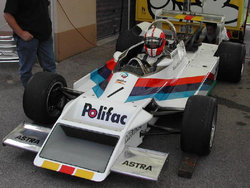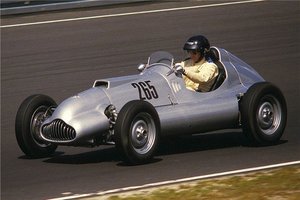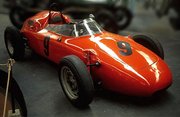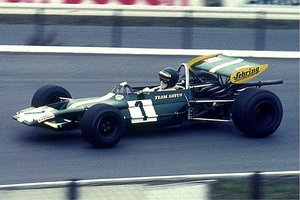Formula 2

Formula Two, abbreviated to F2, is a type of formula racing. It was replaced by Formula 3000 in 1985, but in 2009 the Formula Two name returns. The 2009 FIA Formula Two Championship will begin at Valencia on the 31 May. Visit the official F2 website [1] for more information.
History
While Formula One has generally been regarded as the pinnacle of open-wheeled auto racing, the high performance nature of the cars and the expense involved in the series has always meant a need for a path to reach this peak. For much of the history of Formula One, Formula Two has represented the penultimate step on the motorsport ladder.
Pre-war
Prior to the Second World War, there usually existed a division of racing for cars smaller and less powerful than Grand Prix racers. This category was usually called voiturette ("small car") racing and provided a means for amateur or less experienced drivers and smaller marques to prove themselves. By the outbreak of war, the rules for voiturette racing permitted 1.5 L supercharged engines; Grand Prix cars were permitted 3.0 L supercharged or 4.5 L "normally aspirated" (unsupercharged).
Official beginnings (post war–1953)

In 1946, the 3.0 L supercharged rules were abandoned and Formulae A and B (later 1 and 2) introduced. Formula A permitted the old 4.5 L normally aspirated cars, but as the 3.0 L supercharged cars were more than a match for these (and the pre-War German and Italian cars were no longer available), the old 1.5 L voiturette formula replaced 3.0 L supercharged cars in an attempt to equalise performance. This left no category below Formula A/Formula 1, so Formula Two (originally known as Formula B) was first formally codified in 1948 by FIA as a smaller and cheaper complement to the Grand Prix cars of the era.
The engines were smaller and less powerful than those used in Formula One, and the cars were also smaller, lighter and cheaper than their big brothers, having two litre normally aspirated or 750 cc supercharged engines (an option that was very rarely used). This encouraged new marques such as Cooper to move up to Formula Two, rather than to compete against the big manufacturers of Alfa Romeo and Maserati. In fact, Formula One in its early years was so expensive and entrants were so few that in 1952 and 1953 all World Championship Grand Prix races were run in Formula Two (although non-championship F1 events continued to be held - the Indianapolis 500 was part of the World Championship between 1950 and 1960 but ran to its own regulations and was never formally a Formula One race).
The 1.5 litre era (1957–1960)
F2 went into decline with the arrival of the 2.5 L F1 in 1954 (with small-capacity sports car racing becoming particularly popular), but a new Formula Two was introduced for 1957, for 1.5 L cars. This became dominated by rear-engined Coopers drawing on their Formula 3 and 'Bobtail' sports car, with Porsches based on their RSK sports cars enjoying some success. Ferrari originally developed their 'Sharknose' Dino 156 as an F2, while still racing front-engined Grand Prix cars. The dominant engine of this formula was the Coventry-Climax FPF four cylinder, with the rare Borgward sixteen-valve unit enjoying some success.
A slightly-enlarged version of the F2 Cooper won the first two F1 Grands Prix in 1958, marking the beginning of the rear-engined era in F1. The 1.5 L formula was short-lived, with Formula Junior effectively replacing first F3 and then F2 until 1963—but the 1961 1.5 L Formula One was effectively a continuation of this Formula Two.
The Formula Junior interregnum (1961–1963) and the one-litre Formula Two (1964–1966)
Formula Junior was introduced in 1959, an attempt to be all things to all people (both a training formula replacing F3 and a high-level international category below F1 replacing F2), and it was soon realised that there was a need to split it into two new formulae; F2 and F3 were reintroduced for the 1964 season, with F3 requiring one-litre production-based engines (very similar to FJ in fact) with very restricted tuning, and F2 also having a 1.0 L engine size, but permitting pure-bred racing engines. F2 was largely the domain of F1 stars on their "off-days". Engines were mostly by Cosworth (based on Ford blocks) and Honda, though some other units appeared, including various Fiat based units and dedicated racing engines from BMC and BRM.
The 1.6 litre era, and driver grading (1967–1971)
By the late 1960s, with the "Return to Power" of Formula One the gap between F1 and F2 was felt to be too wide, and the introduction of a new 1600 cc production-based engine formula for F2 restored the junior series to its intended role as a feeder series for F1. The most popular 1600 cc engine was the Cosworth FVA, the sixteen-valve head on a four cylinder Cortina block that was effectively the "proof of concept" for the legendary DFV. The 1967 FVA (3.373 x 2.72 in) gave 220 bhp @ 9,000 rpm. Other units also appeared, including a four-cylinder BMW and a V6 Dino Ferrari.
Nevertheless, many Formula One pilots continued to drive the smaller and lighter cars on non-championship weekends, and some Grand Prix grids (notably in Germany, where the long circuit at the Nürburgring could cope with large entries) would be a mix of Formula One and Formula Two cars. Jacky Ickx made his Grand Prix debut there in a Formula Two car, qualifying with the fifth fastest time overall. Forced to start behind even the slower Formula One cars, Ickx quickly forced his way back into a points position, only to be forced to retire with broken suspension. Less happily, Jim Clark, regarded as one of the greatest race drivers of all time, was killed in a Formula Two race early in 1968, at the Hockenheimring.
In 1967, the FIA introduced the European Formula Two Championship. Ickx, driving a Matra MS5, won the inaugural championship by 11 points from the Australian, Frank Gardner.
The "invasion" of Formula One drivers in Formula Two ranks (a situation similar to that of Buschwhacking in modern-day NASCAR) was permitted because of the unique grading system used. Any driver with an "A" grading was not permitted to score championship points. A driver gained an "A" rating via various means (that changed somewhat over the years), such as finishing in the points in two Grand Prix events or the top three in two World Sports Car events. The annual Formula Two champion was also granted an A rating for one year, and a Formula One World Champion was A graded for five. This system permitted less experienced drivers to work towards the championship and forward their careers, while allowing senior drivers to keep their hand in during the long breaks between Grands Prix of the time.
In the early years of this formula, Brabham and Lotus were the most numerous constructors, although Ferrari intermittently entered a works team, as did BMW (with Lola and Dornier-built chassis). A number of smaller construtors such as Chevron and GRD also provided cars.
The 2.0 litre era (1972–1984)
In 1972, the formula was changed to increase power by permitting 2.0 L production-based engines—Cosworth BDs and BMW four-cylinder engines dominated the early years, with BMW-powered Marches gradually establishing dominance. For 1976, engines developed purely for racing were permitted to compete, with Renault developing a particularly potent V6; allied to a sponsorship scheme from oil company Elf the formula was briefly dominated by French teams and drivers; BMW started to back a works March team and raised the stakes in the late seventies. Even the Ferrari engine returned briefly with minimal success. The Hart 420R (ultimately derived from the Cosworth BDA) was briefly successful in Marches but most notably in the works Toleman team's cars. Dominant chassis of this era were generally from March and Ralt, with Chevron, the French Elf and Martinis and German Maurers being briefly successful.
Honda returned to F2 in the early 1980s with a powerful V6, but this was very much a works engine and the cost of competing with the works Ralt-Honda team became prohibitive. As a result, grids diminished in size and declining interest in the series threatened it with extinction.
Formula 3000
After the 1984 season, Formula Two was upgraded to Formula 3000 in an attempt to merge F2-style chassis with the normally-aspirated 3000cc Cosworth DFV V8 engines that were by now obsolete in the all-turbocharged Formula One.
GP2 Series
When F3000 was replaced by GP2 Series in 2005, the Formula 2 designation was partly revived. To save money, standard 4000cc V8 engines are used in order to provide 580 hp at low cost. They are larger but in a much lower state of tune than the F1 engines that were reduced from 3000 to 2400cc.
FIA Formula Two Championship
Main article FIA Formula Two Championship
Following an absence of 25 years, the Formula Two name will return in 2009 following an FIA announcement on the 25 June 2008.
MotorSport Vision (MSV) won the tender to supply chassis and engines for the new FIA Formula Two Championship, following a fax vote of the FIA World Motor Sport Council. As part of the winning tender it was agreed that MSV will be the promoter of the Championship as well as the operating entity for all of the cars.
The Championship will comprise eight events in Europe between the months of May and November. There will be two races per weekend - each will be 110km long (around 40 minutes) - with the second race to include a mandatory pit stop. 2x 30 minute practice sessions and 2x 30 qualifying sessions will precede both races. There will be three days of official testing throughout the season - three before the first race of the season and another two during the season. At each of these tests a maximum of 300km may be undertaken. Testing will also be possible at MSV’s Bedford Autodrome test circuit. This will be restricted to the opportunity for 50km shakedown tests before any event and a maximum of 1000km in the 2009 season.
The cars will be designed by Williams Grand Prix Engineering Ltd and prepared by MotorSport Vision (MSV). The open wheel chassis will be powered by a 1.8L turbocharged Audi engine developed by Mountune Racing. The new F2 cars are aimed to fall between F1 and F3 in performance. MSV, owned by former Formula One pilot Jonathan Palmer, also runs the British series Formula Palmer Audi, as well as the British Superbike Championship.
Other Formula Two series
Japanese Formula Two
Japan ran a series known as "Formula 2000" to similar rules to two-litre F2 for several years. Production-based single-cam engines were permitted to run at 2.4 L, but they soon came into line with FIA rules in the mid 1970s. The Japanese F2 series ran for two years after the end of European F2, before Japan too adopted a set of regulations very similar to F3000 rules. The series is now known as Formula Nippon. Japan also ran a series for full-bodied versions of F2 cars called Grand Champion - somewhat akin to the F5000-based revival of Can-Am.
Australian Formula 2
Australia still has a local Formula 2 category. The cars are powered by production-based single-cam engines, with an engine capacity between 1100 cc and 1600 cc. The engines are carburetored and have an 8500 rpm rev limit.
Mexican Formula Two
Mexico ran its own Formula Two series (previously known as Formula K) for many years in the 1980s and early 1990s. The cars were similar to Formula Atlantic vehicles, fitted with 2.2 L Chrysler engines.
British Formula Two
The British Formula 3000 series was briefly known as "Formula Two" in an attempt to make its status more apparent to casual spectators. Sadly the series was in terminal decline and the change of name did not help. At one point the use of 4.2 L TVR engines cars in F3000 chassis was discussed as a possible British F2, but this did not materialise.
European Formula Two champions


